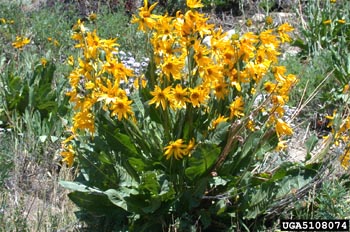Mulesear

Common Name(s):
Mulesear
Wyethia
Scientific Name:
Wyethia amplexicaulis (Nutt.) Nutt
Scientific Name Synonyms:
Espeletia amplexicaulis Nutt.
Symbol:
WYAM
Description:
Life Span: Perennial
Origin: Native
Season: Cool
Growth Characteristics: An erect forb, growing 1 to 2 feet tall, with 1 stem growing from a simple or branching taproot. Flowers May to July, reproduces from seeds and branching taproot.
Flowers/Inflorescence: Large, yellow, sunflower-like, solitary on stem, up to 4 inches in diameter.
Fruits: Fruit is an achene.
Leaves: Large, dark green, glossy, lance-shaped (like mule ears). They are alternate if on stem, but mostly basal. The surface is glossy or hairy. Leaves can grow up to 16 inches long.
Ecological Adaptions:
Mulesear grows on open flats, gentle slopes, and parks from the sagebrush-bluebunch wheatgrass zones through the ponderosa pine and aspen types up into the spruce-fir zones. It can grow at elevations up to 9000 feet.
Mulesear sprouts from underground rootstalks or from the root crown following damage to above-ground portions of the plant.
Soils: Found mainly on clay soils and persist there. It can also be found on gravelly soils.
Associated Species: Cheatgrass, big sagebrush, rabbitbrush, mountain brome, aspen.
Uses and Management:
Mulesear is poor forage for cattle, horses, deer and elk. It is poor to fair for sheep. The immature foliage is most frequently consumed. All classes of livestock and big game eat the flower heads. It is often a sign of past overuse of a site, usually by sheep. It is strongly aromatic.
American Indians fermented roots of mulesear for 2 days in a pit heated with hot stones to develop a sweet flavored food.

